Bob Marchant Part One: the boy from the Wimmera
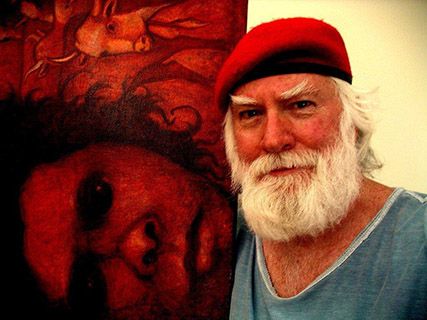
In the July Mailbag there was an item from Andrew in the Hunter Valley of two ceramic plates made by Australian artist Bob Marchant. I liked the plates very much as they represent a very different style and so I did some researching and discovered that Bob Marchant won the Sulman Prize - twice in fact - in 1987 and 1988. But first I will let Bob tell you a little about himself.

The Wimmera District of Victoria, Australia 2
I was born 1938, in Dimboola, a small farming town in (the Wimmera District of) Victoria. My mother told me I was born with a pencil in my hand. Aged 10 my art teacher at school told me I was born to paint. In 1954-58 I was sent to study art at RMIT in Melbourne. After receiving my diploma I travelled to Europe in 1960 and worked in London as an art director until 1980. Then I returned to Australia, living in Sydney and began painting full time.
My paintings quickly came into prominence in 1988 when Margaret Olley judged my painting titled, “The Grand Parade at the Sydney Show” the winner of The Sulman Prize. In 1989 John Olsen was the judge and once again I was awarded The Sulman Prize at the Gallery of NSW. Other major art prizes won include, The Mosman Art Prize. Also The Banjo Patterson Art Prize. In 1996 my series of 14 paintings titled “The Drovers Boy” was selected to tour Regional Galleries and were featured on TV in the ABC Review Program.
I regularly exhibit in Sydney, and have had solo exhibitions in Melbourne, Adelaide and Perth. Also solo exhibitions abroad in Los Angeles, Honolulu and France. In 2001 I completed a large painting commissioned by the Australian War Museum in Canberra to celebrate the 60th anniversary since the Museum was opened. Other important commissions include 2 large paintings for the walls of the Australian Embassy in Tokyo. Bob Marchant 3
Bob sent me a photo of his 1988 Sulman winning painting which was titled: Grand Parade - The Royal Easter Show, Sydney. The amount of detail is amazing and I am sorry we can't show you a larger image. Wonderful childhood memories nevertheless will come flooding back for those of us who have experienced various forms of the "Grand Parade* of animals.
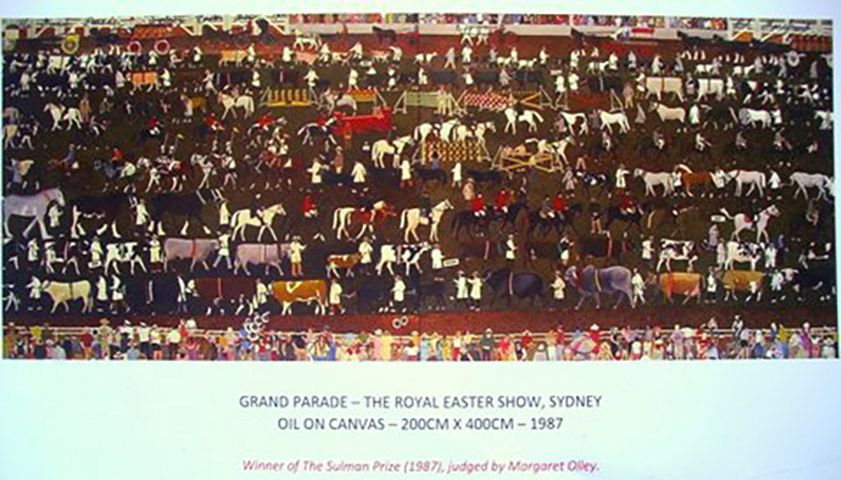
In 1992 Bob Marchant won The Mosman Art Prize with The Young Don Bradman, oil on canvas, 50cm x 50cm. For those of you who live away from Australia, Donald Bradman was Australia's best known and most loved cricketer who practised as children, as did all Australian cricketers, in their backyards.
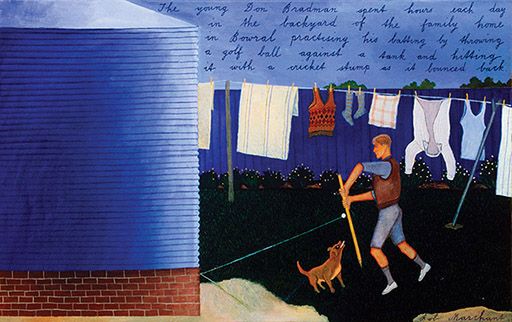
The style used by Bob Marchant for The Young Don Bradman is very interesting as it contains remnants of the style used by Jeffrey Smart in the corrugated iron water tank and rows of bricks. The inclusion of the scrap of paper with explanatory information is wonderful and adds extra narrative details to a painting created strongly in the genre style.
It's not possible to bring you images directly from Bob Marchant's website but please follow this link to see other paintings on the themes The Wimmera, Sport, The Drover's Boy and more.
In correspondence with Bob he has stressed that Each of my paintings have a personal story behind them. Dreams and experiences that I have enjoyed for the last 80 years.
In 1996 Bob's series of 14 paintings titled The Drover's Boy was chosen to tour regional galleries and was featured on TV in the ABC Review Program. As these images recreate the raw narrative of the outback, many are quite confronting.
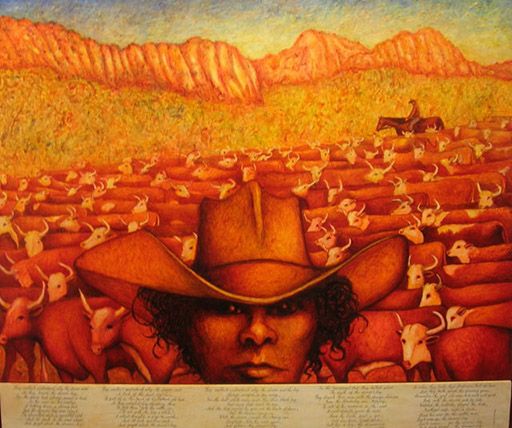
The harrowing history of aboriginal women in the song The Drover's Boy sent chills down the spine of artist Bob Marchant and inspired a series of 14 paintings. "How does it feel to have influenced another artist with your song?" I asked Ted Egan. "It feels terrific. It's humbling because I feel the story is bigger than any of us. The story in question revolves around the bizarre and harrowing practice, rife at the beginning of the century, of capturing Aboriginal women for sexual exploitation. Beginning in the 1880s with the mass migration of cattle from NSW through Queensland and the Northern Territory to the Kimberley, drovers would often snaffle a native women, put a rope around her neck and drag her along by foot behind the horses. Back in camp they would chain her to a tree until she was "tamed". Because interracial relationships were outlawed, the women would be dressed as boys and work as stock riders with the drover. Egan's sparse yet explicit lyrics speak of "the massacre in the west"...
Nell Schofield writing for the Sydney Morning Herald 9
In 2001 Bob Marchant completed a large painting commissioned by The Australian War Museum in Canberra to celebrate the 60th anniversary of the museum opening. Other commissions include two large paintings for the foyer of The Australian Embassy in Tokyo.
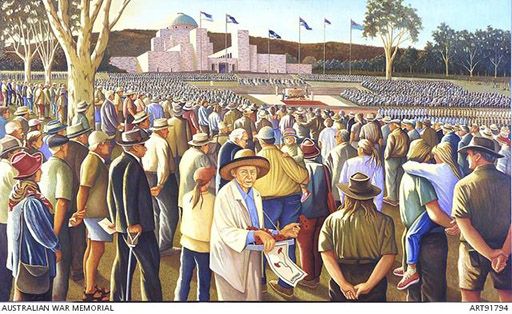
This is a wonderful painting which, for me at least, has a feel of a Norman Rockwell style about it.
I can also feel the Australian artist Russell Drysdale in many of the paintings by Bob Marchant - remembering that Drysdale was one of the first Australian artists to reveal in paint the complexity of the relationships that exist between the Australian peoples, of all ilks, and the landscape on which they live.
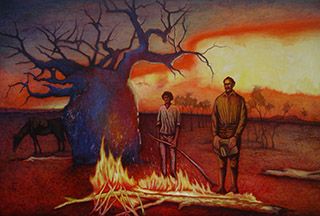
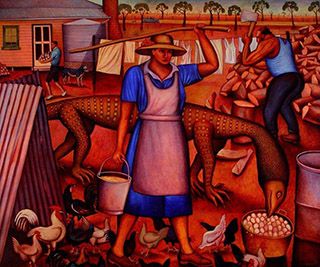
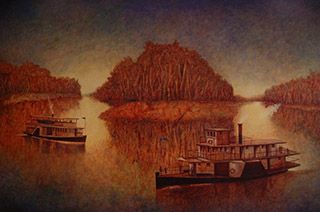
Marchant’s paintings are predominantly figurative and my favourite would have to be In Preparation for the Birth. Here we see a pregnant woman standing in water with her family/friends and some sheep. The weather is so hot that the sheep and woman alike are trying to cool down. It is a delightfully amusing painting as the women, just like country women do, are knitting - in preparation for the birth. Note the strength of the reflections which add to the intensity of the composition and colours.
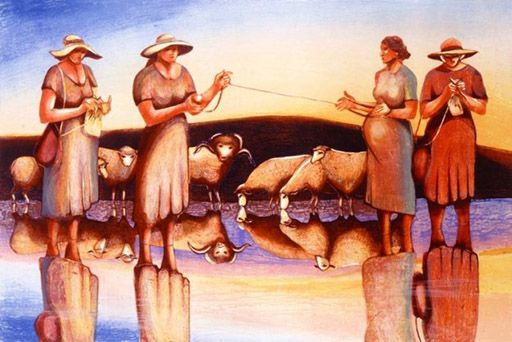
“It is the essential Australianness of both his paintings and their subject which is at the heart of their appeal – unpretentious, direct, unambiguous, quirky and ingenious”.
Gavin Fry, Director of Newcastle Regional Museum, 2001 9
Bob and his wife (ceramic artist Inger Marchant) now live in Bundeena a suburb of Sydney. Tomorrow, I will share some of the more recent paintings being created by Bob which are in a vastly different style to the ones you have seen today.
© Thank you to Bob Marchant who kindly gave permission for the images of his work to be shared on AnArt4Life.
Late mail
A very warm Aussie welcome to M.S. in Australia who has just joined us as a subscriber to the AnArt4Life blog.
Credits
1. Bob Marchant - facebook.com
2. rdv.vic.gov.au
3. arttrail.com.au
4. Provided by Bob Marchant
5. mosmanartgallery.org.au
6. australiangalleries.com.au
7. awm.gov.au
8. artbrokerage.com
9. bobmarchant.net
